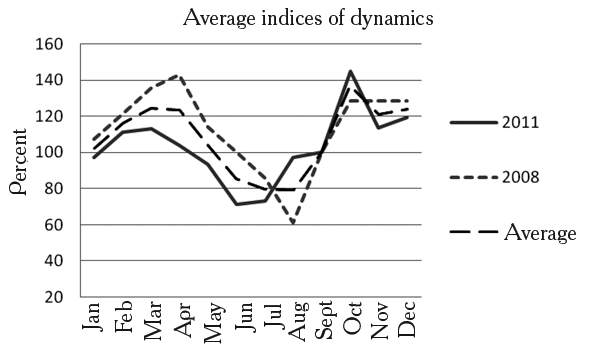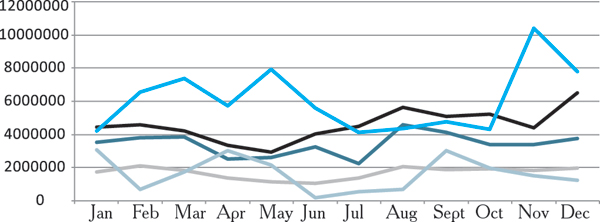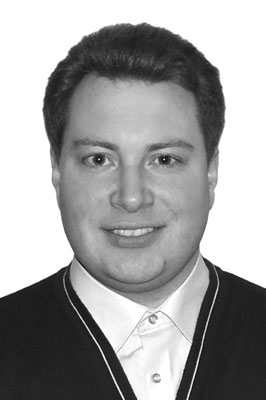Cyclicity of Economical Activity of Sports and Fitness Clubs
Фотографии:
ˑ:
E.V. Krasnov, candidate
Plekhanov Russian university of Economics, Moscow
Key words: cyclicity of economical activity, economic indicators of operation of fitness club.
Introduction. It has been historically established that mankind strives to make its future more predictable and manageable, submit it to its will. This specifics of character is also popular in economy. It has been marked by scientists long ago that economy is characterized by cyclicity of development. And they made attempts to determine the factors influencing the formation of these cycles.
The global financial crisis of 2008 contributed to the significant growth of interest of scientists in the problems of cyclic development of economy. This issue has become increasingly common in speeches, and more publications have been found. The theory of cycles in economical activity is going through its regular youth and is in high demand [6, 1, 2, 7]. Nowadays the researches of the following authors: S. Glaz'ev, D. Belousova, K. Perez, V. Dement’ev, D. L’vov, are of the greatest interest.
Seeking for the works devoted to studies of cyclicity elements in the work of sport and heath clubs and fitness clubs in particular, the researchers faced the lack of information on the issue in the open sources [8, 9]. There are very few publications on this topic and the main information exchange between experts takes place within conference presentations and themed round tables at sports exhibitions. In our opinion, the most interesting speeches are by the following experts they made in different years: O. Malygina, E.B. Myakinchenko, A.A. Yusina [5]. The speeches were made at the fitness festival MIOFF (Moscow International Open Fitness Festival), the fitness summit “FitHit”, the fitness convention “WorldClass” [10-12].
Generally, experts considered in their speeches practical aspects of commercial fitness clubs in Russia and in the world [13]. Short annual cycles associated with the demand for fitness club services throughout the year are the main issue they discussed.
The range of problems of the studies of cyclicity of economical activity of sports and fitness centers is rather relevant, since the received data affect directly the economic activity being carried out by organizations.
The purpose of the study was to examine the income flows from sales of basic fitness club cards.
Results of the study. At the phase of launching and operation of a fitness club accurate forecasts of sales of basic commodities and services need to be made. The lack of forecasting activity carries a high risk of seasonal sales that need to be forecasted and taken into account. Some experts assume that seasonal fluctuations of the level of sales volumes of fitness services can reach up to 50% [5]. An example of the level of seasonal fluctuations of sales volumes of fitness services by month is adduced in Tab. 1.
Table 1. The dynamics of sales volumes of fitness services by month throughout the year in fitness clubs of Moscow, the Moscow region and regions of Russia [7].
|
Month |
Jan |
Feb |
Mar |
Apr |
May |
Jun |
Jul |
Aug |
Sept |
Oct |
Nov |
Dec |
|
Percent of the sales volume in April |
75 |
85 |
95 |
100 |
80 |
70 |
60 |
55 |
70 |
90 |
90 |
90 |
The relative indices of sales of club cards by month are given in Table 1. The sales in April are taken as 100%. The data, stipulated in Tab. 1, are given by fitness expert O.V. Malygina within the speech at the II Russian session of experts of sports and wellness industry and fitness in 2008 [5].
In our opinion, the indices of income flows from sales of fitness services, listed in Tab. 1, need to be supplemented and clarified. This is due to the significant development and complication of the market over the last few years. In many ways, these changes were provoked by the global economic crisis. For example, the clubs of the economic segment became widespread during and after the crisis, that had been developing relatively slowly before the crisis towards the higher price segments of the market of fitness services, represented in Russia. The dynamics of sales volumes can be very different throughout the year in different segments of the market, which should be considered when making revenue forecasts for clubs. At the same time, recently there is hardly any reliable information in the open access on the dynamics of sales of services by fitness clubs and commercial sports organizations [4].
The dynamics of revenue from sales of club cards in clubs from different price brackets was analyzed to expand the existing ideas on the dynamics of revenue from sales of main fitness club cards throughout the year [4]. The data of 16 active clubs for 2011 were applied. The data of new clubs with presales were not used. The obtained data were processed, averaged and presented in Tab. 2. The indices of sales of other months were related to September ones.
Table 2. The dynamics of sales of fitness services by month throughout the year
|
Year |
Percent |
Average |
|||||||||||
|
2011 |
97 |
111 |
113 |
104 |
93 |
71 |
73 |
97 |
100 |
145 |
114 |
120 |
104 |
|
2008 |
107 |
121 |
136 |
143 |
114 |
100 |
86 |
61 |
100 |
129 |
129 |
129 |
113 |
|
Average |
102 |
116 |
124 |
123 |
104 |
86 |
79 |
79 |
100 |
137 |
121 |
124 |
109 |
The data of Tab. 2 were represented by a diagram in Fig. 1.
As follows from Fig. 1, the curve of the indices collected for 2011, and the indices till 2008 differ. So, in the data for 2011 the month of the biggest sales falls not on spring, but on autumn. The pronounced fall in sales was eliminated in August probably due to changing the club prevention policy of the sharp drop of sales in August, which is very bad for business. In this period many clubs hold special advertisement campaigns, introduce special products intended to attract clients. Such a behavior also reflects the level of increased competition. Moreover, comparing the diagrams, the increased in the recent years contribution of sales in the second half of the year compared with the first half is to be marked.

Fig. 1. Average indices of dynamics of revenues from sales of club cards by month (sales in September are taken as 100%)
In addition to the obtained data Fig. 1 contains an example of monthly sales of five different clubs throughout the year. Such a comparison is made intentionally, to stress the considerable spread of values and dynamics of indices of different clubs.
As follows from Fig. 2, different clubs have individual fluctuations in the sales level from one month to another. Such an index as standard deviation of indices of sales dynamics by month was proved to poorly characterize the club success. With the further growth of the number of statistical data the diagram, presented in Fig. 2, will be more accurate in showing the objective rules of changes of the sales dynamics. But, as it has been marked above, the process of acquisition of this data is very complicated. Not to mention supplementing the revenue indicators with detailed costs indicators, which would ensure better understanding and forecasting of success in work of a club. The Fig. 2 contains average benchmarks for clubs, that contribute to forecasting the dynamics of individual indicators and comparing own club with other clubs. Herewith, it is clear that every club has its optimal schedule with individual peculiarities. So it is appropriate to use more accurate forecasts of the average diagram on Fig. 1, but not a single one, for example for 2008 or 2011.

Fig. 2. The example of sales of five different clubs throughout the year
Undoubtedly, the dynamics of club sales rates is associated not only with seasons, but with numerous other important factors. For example, with the concept of positioning of a club on the market, quality of management, arising cash deficiency, causing dumping for the soonest call for funds, competitive position etc. Herewith, the seasonal factor in the industry is real and pronounced. A single commercial fitness club is extremely vulnerable in case of such significant fluctuation in sales dynamics. One failed season is enough to drive the company to the verge of bankruptcy. In such a situation it is advisable to make short-term forecasts, for example for 3-6 months, but not longer ones. Certainly, the year plan-forecast is required, but it is also important to be aware of the high level of lapse rate, taken into account at the phase of uncertainty of markets, where many single clubs and small networks are operating at the moment. The work forecast can be shorter and under stricter control. Fitness club is better have a year plan (approximate), 6, 3 months and 1 month plans. Implementation of a month plan should be controlled not less than twice a month taking into account the existing in the industry specifics of sales dynamics within a month, when sales in the second part of the month are usually higher than in the first one. In this situation it is easier for network operators to smooth the seasonal fluctuations. Thus assumption is confirmed in the growing number of network operators in the market. Investors join projects, immediately aiming at opening 3-5 clubs within one-two years.
The specific cyclicity of sales can be found even within sakes during one month. The dynamics of sales in different months has much in common. So, for example, the trend to increase sales is expressed in the second half or even the third of month. It is characteristic for most months of the year.
Conclusions. Cyclicity elements in a number of economic indicators of the year work are typical for operating fitness clubs.
The suggested in the paper income flows indices from the sales of the basic fitness club services (club cards) during the year can be used for precise predicting sales and diagnosis of the state of the club. For this purpose one is to use the values submitted in the average diagram on Fig. 1.
Every club has been proved to have its individual, typical peculiarities of income flows. It has been found out that seasons render a significant influence on sales within a year. The researchers give proof of the necessity of predicting sales with the focus on one and three month periods, and the dynamics of sales can be notably different in various market segments.
References
- Glaz’ev, S. It has started already / S. Glaz’ev. Electronic access. http://expert.ru/expert/2012/02/uzhe-nachalos/?n=172 (In Russian)
- Glaz’ev, S. How to construct new economy. Electronic access. http://expert.ru/expert/2012/07/kak-postroit-novuyu-ekonomiku/ (In Russian)
- Report of the company PricewaterhouseCooper. “Perspectives of development of world sports industry till 2015”. – 2011. – 40 P. Electronic access. www.pwc.ru/sportsoutlook (In Russian)
- Krasnov, E.V. On classification of fitness clubs in Russia / E.V. Krasnov. Electronic access. http://www.fitnessexpert.ru/index.php/fblog/stati/351-k-voprosu-o-klassi... (In Russian)
- Malygina, O.V. Proceedings of the speech at the II All-Russia session of experts of sports and fitness industry and fitness, 2008. (In Russian)
- Medovnikov, D. “The die is not thrown yet” / D. Medovnikov, S. Rozmirovich, V. Saraev. Electronic access. http://expert.ru/expert/2012/02/zhrebij-esche-ne-broshen (In Russian)
- Oganesyan, T. “Twenty years before the boom” / T. Oganesyan. Electronic access. http://expert.ru/expert/2012/02/za-dvadtsat-let-do-buma/?n=172 (In Russian)
- Orlov, A.V. Sport and sports industry: Public administration. Management. Marketing: monograph. / A.V. Orlov. – Moscow: Rialteks, 2011 – 172 P. (In Russian)
- The strategy of development of physical culture and sport in the Russian Federation на период до 2020. Electronic access. http://www.infosport.ru/strategiya (In Russian)
- www.mioff.ru (In Russian)
- www.fithit.ru (In Russian)
- www.fitness-convention.ru (In Russian)
- The IHRSA Global report. The state of the health club industry, 2011. – 92 P.
Author’s contacts: ev_krasnov@mail.ru




 Журнал "THEORY AND PRACTICE
Журнал "THEORY AND PRACTICE